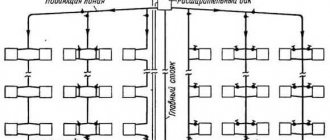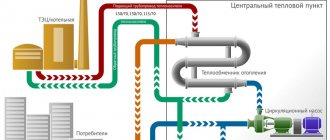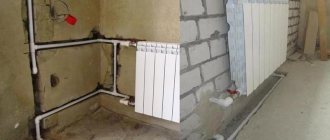Many buildings were erected during the Soviet era. And, despite the fact that they are often in a dilapidated state, authorities do not often think about the need to change heating elements. You have to solve this problem yourself. Replacing heating batteries in an apartment is especially troublesome.
The fact is that the vast majority of people are faced with the need to change radiators once in their lives: where does experience come from in this state of affairs? Our material will be a good guide that can be safely used when carrying out this type of repair and construction work.
Sequencing
Replacing the battery involves several stages. In general, the scheme of events looks like this:
- coordination of work with utility services;
- dismantling an old, failed heating system;
- installation of new radiators;
- preparing the pipeline for work;
- test work;
- putting into operation.
Collection of documents and preparation
The first stage is to shut off and release the water. It is carried out exclusively by housing department employees, who must be contacted initially. You also need to discuss with your neighbors the installation of new heating appliances.
To obtain permission, you need to submit to the housing department an application about the need to change the radiators, as well as Certificates of Conformity for radiators and components (fittings, pipes) and thermal calculations of new batteries. What to do with the latter? In fact, making a design for new devices is not difficult - this data is taken from the radiator data sheet.
After collecting the documents, it is necessary to obtain from the contractor company that agrees to change the batteries a copy of the SRO certificate of admission to such work - this is a mandatory condition that guarantees quality.
Equipment selection
Replacing heating radiators in an apartment is possible only with batteries that comply with GOST. If this is not done, then you can harm the entire heating system in an apartment building: some apartments will be hot, while others will be cold.
Before removing the heating radiator, you need to cut the riser pipe at the top and bottom. After which the battery is disconnected at the joints from the heating system and removed from the brackets. Separation from the pipe is carried out using a special key, but if this fails, then you should simply cut off the battery. This stage should only be carried out at the end of the heating season.
The next step is to directly replace the batteries. Very often the battery consists of several - 7-8 - sections. If this is provided for by the project, you need to purchase and connect several of these components, for which you will have to use special keys.
Battery replacement procedure
If your old batteries have valves, then you can replace the battery without resorting to draining the water from the risers; you just need to turn off the taps, cut off the old battery (with the assistance of a mechanic or yourself) and attach a new one, then open the valves and check the tightness of the connections.
If there are no valves on old batteries, the replacement procedure consists of the following steps:
- contacting the housing office or departmental office, where the necessary documents are prepared and a receipt is issued;
- payment of the receipt at any bank branch or via the Internet.
The cost of disconnecting and draining one riser, depending on the region, can vary from 300 to 3000 rubles per hour of disconnection.
3. on the appointed day and time, several employees of the housing office/daily office carry out joint replacement work: the riser is turned off and drained, the battery is replaced and then pressure is applied to the heating system and the quality of work is checked.
In general, replacing a battery in winter is only slightly different from replacing it during the non-heating season and takes a little longer. Usually the procedure lasts 1-2 hours, so in order to avoid unpleasant situations, you must notify your neighbors in advance about your plans.
Installation of equipment
After marking the surface, the fasteners are mounted, so that there is a gap of 40 mm between the battery and the wall. Then you can proceed directly to installing the battery, or you can do this after installing the pipeline.
For the system to work, water circulation must be ensured through the installation of pipes. It is important not to change the established power and volume indicators so that they correspond to operating conditions. As a rule, this point is discussed at the approval stage.
To give the pipe the desired size, it should be cut with special scissors. The pipes are then secured to the system using a welding machine. Exactly the same operation is performed with the battery. When everything is ready, you can proceed to testing.
Examination
The best option is to check the functionality together with housing department employees. The equipment must ensure uniform heat distribution without any malfunctions. The last step is crimping. This procedure is carried out by house management specialists. Once the system is pressurized, it is considered ready for use.
When is the best time to change heating batteries? | ThermoConnect
When is the best time to change heating batteries?
One of the benefits of civilization is centralized heating. Most often, the question of replacing heating batteries comes before us during the renovation of the entire apartment, because we don’t want an island of antiquity to remain against the background of the updated interior - rusty, cast-iron, battered radiators, like an architectural monument. Since the heating installation process is labor-intensive and costly, a typical question is what time of year to choose to replace batteries in order to avoid unnecessary financial investments and emotional turmoil. On the website https://santeh-master36.ru you can order a battery replacement service at a discount.
So, let's look at options for replacing heating at different times of the year.
There is an opinion that it is better to replace heating in the summer, when the previous heating season is over and there is still time before the new one. And this is the first and main misconception. Despite the fact that during the non-heating season the batteries are cold, there is water there, since if it is not there, the batteries will simply become overgrown with rust. That is, if you decide to replace the heating system in the summer or spring, you will still need to contact the housing office so that the workers give permission or themselves drain the water from the system so that you can install the heating. The exception is when the utilities themselves carry out scheduled work to replace pumps, pipes, etc., the so-called preparation for winter.
It’s good if your plans coincide with the plans of the housing office. Otherwise, you will have to contact the chief engineer of the management company and clarify whether there is water in the risers or whether it needs to be drained. Of course, this is quite simple to do, especially since at above-zero temperatures outside the need for heating is not as great as at -20°C. And this is the main advantage of replacing heating in spring and summer. But there is also a minus - you can check whether everything has been done conscientiously only at the beginning of the heating season, when water under pressure enters the risers. And here unpleasant surprises are possible.
Replacing batteries during the heating season, advantages and disadvantages
As in the case of spring (summer), when replacing batteries during the heating season, before carrying out work, you must enlist the support of the housing office in the matter of turning off the heating risers. To do this, submit a paper application to the responsible person of the management company (chief engineer) and, having paid the issued receipt in the bank (online), you can begin work. Since the procedure for freeing risers from water is paid, housing and communal services employees will easily satisfy your request.
The main advantage of the autumn-winter installation of heating is a quick check of the quality of the work performed, because it is no secret that leaks can form in the welding areas and on the threads, and it is better to eliminate it immediately by repeating, higher-quality welding. In addition, during the heating season there are seasonal discounts on welding work, which is another plus. There is only one minus - you will have to freeze a little, which means you need to act quickly. Of course, it is not only the issue of the beauty of the interior that serves as a reason for replacing the batteries. If in winter the apartment is cold and uncomfortable, and the housing office cannot help resolve the issue, it means that hot water does not reach the radiators due to wear and tear on the heating system. Either replacing the batteries or using an infrared heater will help.
We also recommend reading:
www.termoconnect.ru
Useful little things
Initially, you need to take care of the availability of special tools. If you have to replace the heating batteries yourself, then simply sketching the project will not be enough - you need to understand every nuance of the installation. At a minimum, it is worth adopting a few basic rules.
So, the battery must be installed at an angle: otherwise air will accumulate in it, which will have to be blown out so that the heat transfer efficiency of the radiator does not decrease. If we are talking about installing a cast iron radiator, then it should be disassembled and reassembled before installation.
There are a number of other points that are worth paying attention to. To get a more complete picture, you need to consult with specialists or search for information on the Internet in advance. Replacing batteries is a truly labor-intensive process that requires scrupulous technology.
Replacing heating batteries in an apartment through the management housing office
At the time of an accident (for example, a radiator has leaked), replacing the heating battery lies entirely within the responsibility of the organization, to whose account residents transfer money for maintaining common property and carrying out major repairs. It cannot be said that such a replacement occurs free of charge. Cases of coercion to purchase new devices are not uncommon. It happens that receipts are issued for the cost of work performed.
The most unpleasant thing is if the battery replacement process is needed in emergency mode during the heating season. And representatives of the management company will begin to evade their obligations, citing the fact that they have neither time, nor workers, or even the radiators themselves. They will remove the old one, install plugs and politely ask you to wait.
It turns out that residents cannot change the batteries in their apartments if they wish, because...
For example, when the replacement has already been made and you plan to legalize it, you should contact an expert commission, which, in turn, if there are no violations of the design parameters, can confirm the legality of the installation of radiators.
An examination of the compliance of heating units with the primary design and the admissibility of their installation in an apartment without damage to the overall system of the entire house is paid for by the owner of the apartment in which he wants to replace the batteries, because
For example, if the batteries purchased by the owner do not correspond to common house heating devices, then the HOA may prohibit their installation. The apartment resident must carry out such work through the housing office and coordinate with his service organization the replacement of batteries.
https://www.youtube.com/watch{q}v=fPWupSzksOw
If it establishes similar ones to those that were provided for during the design and construction of the house, it is enough just to notify the management company without waiting for a special permit. Coordination of work with the HOA When replacing radiators with heating devices of a different type (different from those envisaged by the architects), increasing its area or choosing a new installation location, an experienced specialist is required who will help calculate the possibility of installing heating devices, since the load on all thermal home network.
In the off season
As a rule, heating batteries are replaced after the end of the heating season. However, situations do not always work out ideally: after testing, it may turn out that the battery is leaking, and accidents may occur.
Therefore, replacing heating batteries in winter is, in general, a common thing. However, there are several nuances to this. Firstly, to install radiators, you need to turn off the riser - you also need to coordinate with the housing office to shut off the water.
A short-term shutdown for a period of no more than three hours is a paid service, for which a motivational explanation (reasons) is written.
Secondly, replacing the heating battery is not allowed during the period of maintenance work and test runs of the system, at a temperature of -10°C, and therefore it is better to choose a warmer day. During the winter season, all work is completed quickly.
There are also advantages to this
This type of heating battery replacement has its pros and cons. The most negative factor is the human one: it is difficult to agree on shutting down the system, since employees of service companies often try to take advantage of the ignorance of their users and issue a refusal.
It must be remembered that refusal and imposition of any fine is illegal; turning off the riser, even in winter, does not in any way affect the rest of the system. But it’s really impossible to change batteries yourself, without obtaining permits, with consequences - this will entail legal penalties.
All work is carried out quickly so that the room does not cool down and cold masses are not transferred to neighboring apartments. The second disadvantage is that the cost of shutdown services increases and the time required to complete the work for the master is reduced, which has already been mentioned above.
But, oddly enough, winter replacement of heating radiators also has positive aspects. After all, with a working scheme, it is easier to check the quality of the installation, which is not the case in the summer, when the system is idle: you can immediately see whether the radiator is leaking, whether the water is circulating well. This provides certain guarantees that the batteries are installed correctly.
Who should change the batteries in an apartment if it is privatized
Real proceedings await those who unauthorizedly changed the radiators in their apartment without approval from the relevant organization.
Even if the leak was not the fault of the tenant and is not related to the installation of new equipment, utility services can make the apartment owner guilty of what happened. Important! Sometimes changing the configuration of heating devices and increasing their number is perceived as re-equipping the premises with amendments to the apartment’s registration certificate. In fact, replacing the battery is not reflected in any way in the technical passport, since only the type of heat source is indicated there without specifying specific heating devices
Battery selection
When choosing any type of radiator, you need to focus not on its aesthetic appearance, but on its quality. So, for a system that will be equipped with a pump, batteries made of any material are suitable, even cast iron, but of a new type, the main thing is that they are compatible with the pipes and the boiler.
If the circulation in the system is natural, then you should pay attention to the fact that they have low hydraulic resistance.
Also, in a situation where it is necessary to replace the heating system in an apartment, it is necessary to take into account a number of important factors:
- The main indicator for new radiators is their size. You need to select them based on the following parameters:
- the distance from the floor should be 8-12 cm;
between the window sill and the battery – 9-12 cm;
- they should move 3-5cm away from the wall.
- The next parameter is the ratio of the metal from which the batteries are made with the coolant indicators. Here you should take into account what its Ph is, the degree of contamination, operating pressure, and maximum heating temperature. Data on the technical characteristics of the coolant must be provided by the Housing Office.
- An equally important factor is the reaction of the metal from which the batteries are made, for example: At high pressure, bimetallic radiators are the best choice, despite their rather high cost. They can withstand from 9 to 12 bar. Some aluminum systems are suitable for such parameters, but they are sensitive to the coolant.
- If the quality of the coolant is poor and there are a lot of suspended particles in it, then you need to opt for cast iron systems, as they tolerate them well.
- In the absence of water treatment, attention should also be paid to the diameter of the collectors. If it is small, then you will have to deal with frequent clogging.
- If Ph is too low (up to 6) or high (9 and above), bimetallic or steel batteries are an excellent choice.
When choosing heating radiators, you should remember that they must occupy at least 70% of the width of the window sill, otherwise the level of heat transfer will decrease and cold zones will appear in the room.
The average indicator for determining power is 100 W/m2. If you compare it with the area of the room, you can find out how much power one radiator section should have. At the same time, we must not forget that it must occupy at least 70% of the wall under the window sill, so focusing on systems with high performance, but shorter ones, does not make sense, since cold air from the window, without receiving obstacles in the form of heat from the battery, will be freely reach the floor.
Only after all parameters have been taken into account can you obtain permission from utility companies to alter the system and begin purchasing radiators.
FAQ
Whatever the reason, any action can be taken only after answers to the questions have been received:
- How much does it cost to replace heating batteries in an apartment?
- What permits are needed for this?
- Who has the right to carry out such work?
- What should I replace old cast iron batteries with?
- Is it possible to replace the heating battery in an apartment for free?
- When is it better to change heating batteries in an apartment?
- How to change the heating battery in an apartment yourself and is it possible?
The heating system of a multi-storey building is a rather complex structure in which many elements must be taken into account. If during the repair or replacement of radiators in one apartment malfunctions occur, the entire riser may suffer.
Is it possible to replace radiators yourself?
If the apartment owners do not have an engineering education with a specialization in heating systems, it is better to entrust the replacement of radiators to professionals. The slightest mistake can lead to the batteries not heating well or starting to leak.
For example, I know stories where, due to lack of knowledge, batteries were connected to the hot water supply system. It seems logical: in order for appliances to heat, hot water must flow into them. But no, radiators can only be connected to the pipes of the heating system, otherwise they will quickly become unusable.
The fact is that the heating system always uses the same water, which is used in a closed cycle. And if there are any harmful impurities in it, their effect on the battery metal is limited. In a hot water supply system, water flows through an open cycle and is constantly renewed, so new impurities will constantly appear, which will harm the radiators over and over again.
Some apartment owners entrust the installation of batteries to teams that do other repair work: laying floors, plastering walls, gluing wallpaper. But they often do not have an engineering education, and they know no more about heating systems than the apartment owner.
The best option is to contact specialists, at least a full-time plumber of the management company. At least if problems arise, there will be someone to file a claim with. The main thing is to get documents from the plumber or management company about the replacement, because replacement without documents is no better than the work of an incomprehensible master from the Internet.
You can also use the services of specialized organizations. When choosing a contractor, it is important to pay attention to several points.
- The company must have a license to install heating systems.
- It is useful to read reviews about a potential contractor and understand how long they have been in business.
- It is necessary to conclude an agreement that will indicate the terms of work, their list, cost and guarantees.
- Finally, it is important that, following the replacement, the technician performs a pressure test of the system (this is also done in the summer). This way it will be possible to detect possible leaks that specialists must eliminate. And only after this is it worth signing a certificate of completion, which will be useful if problems arise with the radiators in the future.










